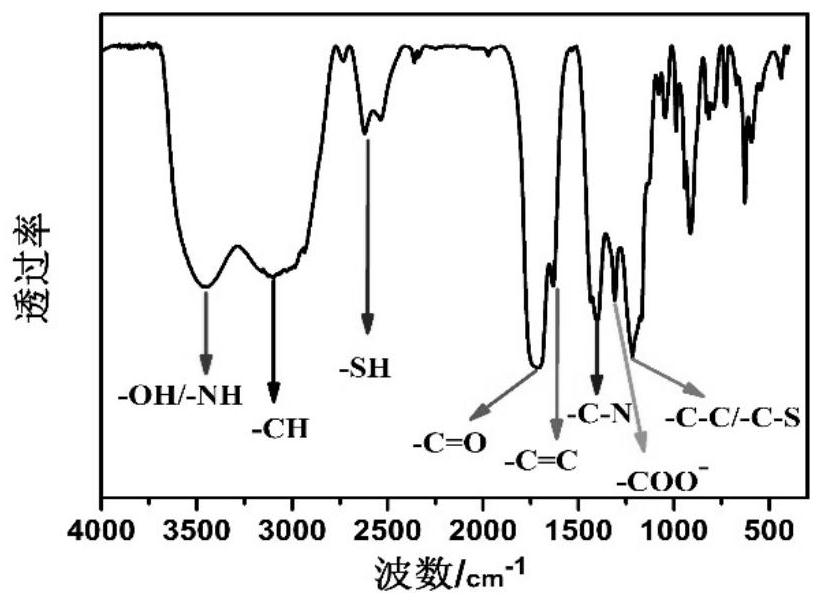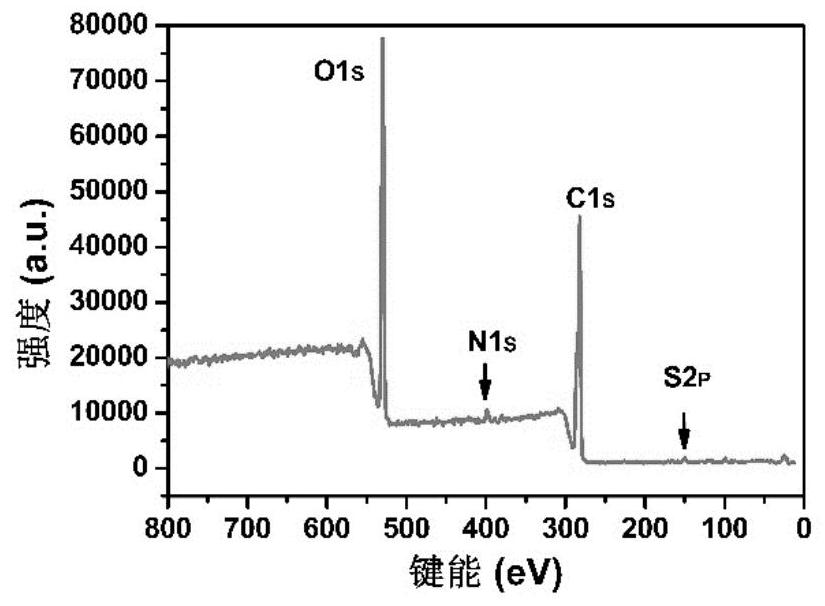A nitrogen-sulfur co-doped carbon quantum dot and its preparation method and application
A carbon quantum dot and solution technology, applied in the detection of hypochlorite ions, sulfur-doped bright yellow fluorescent carbon quantum dots and their preparation, in the field of nitrogen, can solve problems such as occupation, and achieve simple preparation steps and biological Good compatibility and low toxicity
- Summary
- Abstract
- Description
- Claims
- Application Information
AI Technical Summary
Problems solved by technology
Method used
Image
Examples
Embodiment 1
[0036] Step 1, place acid fuchsin and citric acid in the lining of polytetrafluoroethylene hydrothermal reaction kettle, add deionized aqueous solution, fully stir, the mass ratio of acid fuchsin, citric acid, and deionized water is 0.008:3: 30;
[0037] Step 2, put the liner containing the raw materials into the reaction kettle, and then place it in an oven and heat it to 180°C for 12 hours to obtain an orange-yellow liquid;
[0038] Step 3, take out the lining after the reaction kettle is naturally cooled to room temperature, pour the solution into a 500-1000Da dialysis bag for dialysis treatment for 1 day, and change the water every 6 hours to obtain a pure aqueous solution of carbon quantum dots;
[0039] In step 4, the carbon quantum dot aqueous solution obtained above is freeze-dried to obtain the target carbon quantum dot N,S-CDs.
Embodiment 2
[0041]The N,S-CDs prepared in Example 1 were characterized by transmission electron microscopy (TEM), infrared spectroscopy (FTIR) and XPS (see Figure 1-3 ), the particle diameters of the N,S-CDs prepared by the present invention are all less than 10nm, and the surface contains groups such as mercapto, carboxyl, hydroxyl, and amino groups. Dissolve 0.025g of N,S-CDs obtained in Example 1 in 100ml of secondary water, stir well to form 0.25×10 -3 g / ml clear solution. Afterwards, UV absorption spectroscopy and fluorescence excitation emission characterization were carried out (see Figure 4 ). It was found that there is a weak absorption at 450 nm and an emission wavelength of 552 nm under excitation at 375 nm. Then, using rhodamine 6G as a reference and ethanol as a solvent, the relative quantum yield of the carbon dots obtained in step 1 was measured to be 15%. In addition, through measurement, it can be known that the lifetime of the carbon dot is 5.27ns.
Embodiment 3
[0043] Take the 0.25×10 in Example 1 -3 2.5 mL of carbon dot solution at g / ml was placed in a fluorescent cuvette, and 0.02 mL (0.1 mol / L) of 19 common ion solutions were added, mixed evenly, and the emission spectrum was scanned in a fluorescence photometer (λex=378nm, λem=552nm / 470nm), and record the fluorescence intensity, such as Figure 5 Shown, N,S-CDs to ClO - Good ion selectivity, ClO - It can quench the fluorescence of carbon quantum dots at 552nm (see Figure 6 ). Further studies found that the synthesized carbon dots are relatively - It has high sensitivity, has a good linear relationship in the range of 1.6-96μmol / L, and the detection limit is 56nmol (see Figure 6 illustration in ).
PUM
| Property | Measurement | Unit |
|---|---|---|
| particle diameter | aaaaa | aaaaa |
Abstract
Description
Claims
Application Information
 Login to View More
Login to View More - R&D
- Intellectual Property
- Life Sciences
- Materials
- Tech Scout
- Unparalleled Data Quality
- Higher Quality Content
- 60% Fewer Hallucinations
Browse by: Latest US Patents, China's latest patents, Technical Efficacy Thesaurus, Application Domain, Technology Topic, Popular Technical Reports.
© 2025 PatSnap. All rights reserved.Legal|Privacy policy|Modern Slavery Act Transparency Statement|Sitemap|About US| Contact US: help@patsnap.com



